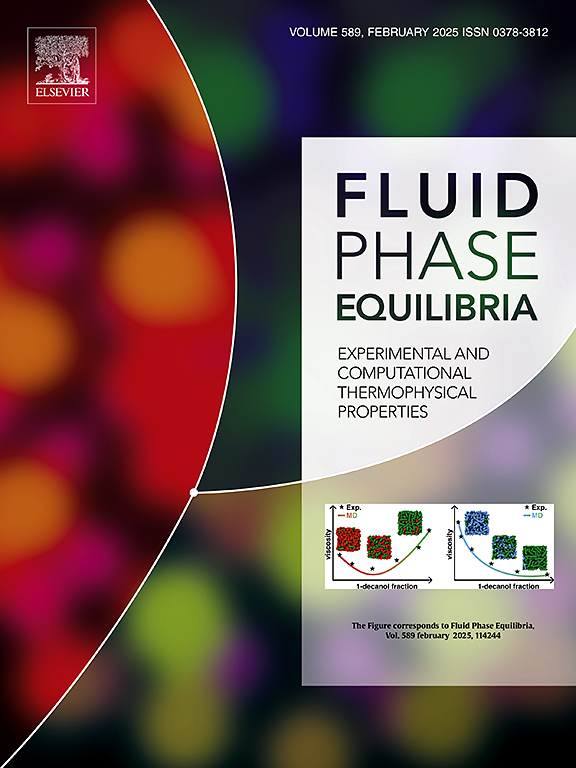Vapour pressure osmometry and liquid density data for binary aqueous solutions of organic salts: Measurement and modelling
IF 2.8
3区 工程技术
Q3 CHEMISTRY, PHYSICAL
引用次数: 0
Abstract
In this work, considering the need for accurate thermophysical data to achieve a reliable thermodynamic description of electrolyte-containing systems, liquid density (298.15 or 313.15 K) and vapour pressure osmometry (313.15 K) studies were conducted for binary aqueous solutions of the organic salts: sodium acetate (Na[Acet]), sodium formate (Na[Form]), sodium gluconate (Na[Glu]), sodium succinate (Na2[Suc]) and potassium formate (K[Form]). Liquid densities were found to be favoured by decreasing temperature and increasing salt molality, following the order Na[Acet] (1006.01–1099.51 kg·m-3) < Na[Form] (1008.13–1120.56 kg·m-3) < K[Form] (1007.73–1119.52 kg·m-3) < Na[Glu] (1009.57–1117.90 kg·m-3) < Na2[Suc] (1005.43–1108.17 kg·m-3) in the common composition range. This property was satisfactorily correlated with salt molality using second-degree polynomials, obtaining low standard deviations and high determination coefficients . Furthermore, vapour pressure osmometry (VPO) studies were carried out, at 313.15 K, for the same solutions, showing a significant reduction of vapour pressure at maximum concentration (Na[Acet]: 1.231 kPa; Na[Form]: 1.318 kPa; Na[Glu]: 0.450 kPa; Na2[Suc]: 0.791 kPa; K[Form]: 1.187 kPa) and generally presenting osmotic coefficients below unity, which implied negative deviations from an ideal solution. Finally, the osmotic coefficients were successfully described using the Extended Pitzer Model of Archer ( and ), which was later applied in the estimation of mean molal activity coefficients and excess Gibbs free energies .

求助全文
约1分钟内获得全文
求助全文
来源期刊

Fluid Phase Equilibria
工程技术-工程:化工
CiteScore
5.30
自引率
15.40%
发文量
223
审稿时长
53 days
期刊介绍:
Fluid Phase Equilibria publishes high-quality papers dealing with experimental, theoretical, and applied research related to equilibrium and transport properties of fluids, solids, and interfaces. Subjects of interest include physical/phase and chemical equilibria; equilibrium and nonequilibrium thermophysical properties; fundamental thermodynamic relations; and stability. The systems central to the journal include pure substances and mixtures of organic and inorganic materials, including polymers, biochemicals, and surfactants with sufficient characterization of composition and purity for the results to be reproduced. Alloys are of interest only when thermodynamic studies are included, purely material studies will not be considered. In all cases, authors are expected to provide physical or chemical interpretations of the results.
Experimental research can include measurements under all conditions of temperature, pressure, and composition, including critical and supercritical. Measurements are to be associated with systems and conditions of fundamental or applied interest, and may not be only a collection of routine data, such as physical property or solubility measurements at limited pressures and temperatures close to ambient, or surfactant studies focussed strictly on micellisation or micelle structure. Papers reporting common data must be accompanied by new physical insights and/or contemporary or new theory or techniques.
 求助内容:
求助内容: 应助结果提醒方式:
应助结果提醒方式:


